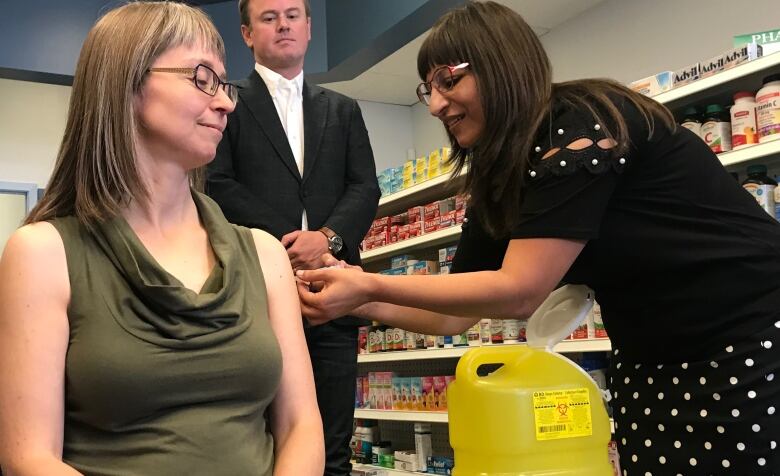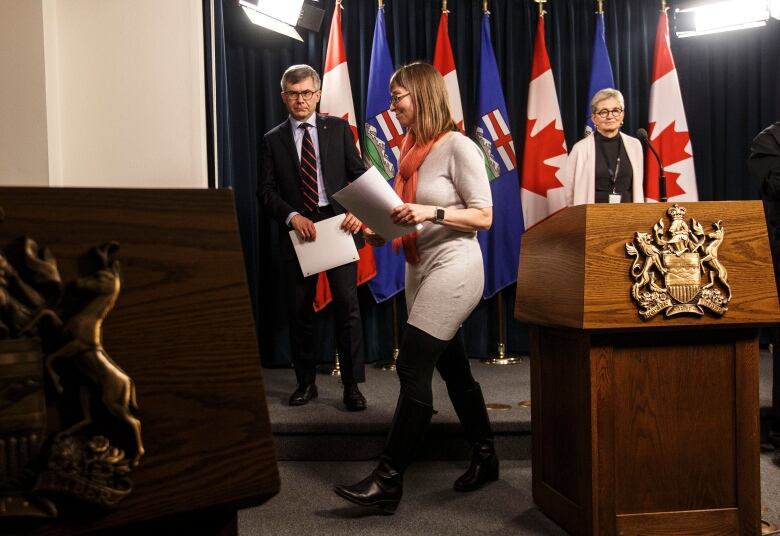Leading with her heart: Long before COVID-19, Deena Hinshaw was making an impression
Even as a student, Hinshaw was 'good enough to take care of my mother': supervisor

Late Monday afternoon, Dr. Deena Hinshaw stepped up to the podium at the Federal Building for her daily COVID-19 address, speaking to thousands of Albertans who were watching from their homes.
She worea red dress and matching red-framed glasses. More importantly, her trademark calm, compassion and composure were firmly in place.
"I would like to begin today by sharing some sad news," she began, before announcingfive more Albertans had died of COVID-19 in the past 24 hours. Her demeanour was steady, her voice only cracking slightly as she said: "Imagining the grief that these families are facing, my heart goes out to them."
Hinshaw's heart is part of what makes her an outstanding doctor and public health leader, and it, too, has been firmly in place, all the way back to her days as a medical student at the University of Alberta.
"Within a week or two, I could often tell and other teachers agree that this is one of the doctors who stands out," says Dr. Mike Donoff, the U of Afaculty of medicine's associate chair and Hinshaw's adviser for her family medicine residency.
"The criteria we jokingly use is that they'll become good enough to take care of my mother."
Following extends from T-shirts to Twitter
Hinshaw was appointed Alberta's chief medical officer of health on Jan. 28, 2019, less than a year before China alerted the World Health Organization to several cases of an unusual pneumonia linked to an unknown virus.
Since Feb. 26, when she provided her first update to Albertans about the novel coronavirus, Hinshaw has become the province's favourite personality.
Her delivery of informationon COVID-19 is consistently calm and collected, brightened every so often when she cracks a smile at a reporter's question. Her reassuring demeanour has won the hearts of thousands.

T-shirts are emblazoned with her image, including her signature hairstyle and glasses. A B.C. clothing designer was barraged with requests for the periodic tabledress Hinshaw wore to a news conference. She ventured onto Twitter in March and within hours had accumulated thousands of followers. She even has her own fan page on Facebook, where the magic of Photoshop has her looking right at home with the cast of The Big Bang Theory, a sitcom about the lives of a group of scientists.
The pandemic has left Hinshaw too busy to be interviewed, so CBC reached out to some of her university advisers, who remember seeing the very qualities that Albertans admire in her today.
Empathy and evidence
In the early 2000s, Hinshaw was a young resident, fresh out of medical school, when she became one of Donoff's students. The two-year family medicine residency was a requirement to complete themaster of public health program she was enrolled in at the time.
Donoff says Hinshaw left an early impression on him, something very few residents manage to do, as he watched the empathy and compassion she showed patients.
Many residents shared that compassion, he says. But few could demonstrate it as well as Hinshaw.
"She would communicate with patients in a way that acknowledged what their concerns were, and explained some of the evidence of our options in a way that empowered patients," he recalls.

Donoff's patients could always request a specific resident, and many would choose to see Hinshaw again.
Less visible to patients was Hinshaw's remarkable commitment to understanding good evidence and her ability to accept when it wasn't available, he said.
Frequently, he explains, new residents who stumble into a grey area might bombard patients with tests and prescriptions.
"It takes a lot of maturity to realize that if you share (with the patient) that you don't know something, the patient and you can usually come up with some suggestions to try," he says.
At the end of her two years, Donoff informed patients that Hinshaw would no longer be seeing them.
"Many patients said to me how much they were really going to miss her."
Rare interest in health care for the elderly
Hinshaw would go on to complete her master of public health program in 2008, while completingher five-year residency in family and community medicine. In 2009, she entered the U of A's care of the elderly diploma program.
"It's so interesting how some residents stick in your mind and she was one of them," says Dr. Jasneet Parmar, associate professor with the U of A's department of family medicine whose expertise is in caring for geriatric populations.
Back then, Hinshaw was a "calm and collected" student whose signature style was an enviably thick braid sans bangs and a simple taste in clothing.
Hinshaw was Parmar's resident for six months at WestView Health Centre in Stony Plain.
"We have never had anybody like this come in and do 'care of elderly' training," Parmar remembers.

When asked why she wanted this diploma in the first place, Hinshaw notedit was an important facet of community medicine, butadded "she was genuinely interested in caring for seniors," Parmar said.
"'This is a gap in my learning,'" Parmar recalls her saying."'I need to learn more.'"
According to a 2019 article in the Canadian Medical Association Journal, geriatrics is rarely chosen by medical trainees as an area of specialization. There are a little more than 300 geriatricians across Canada, with some provinces having only one.
Parmar said Hinshaw was especially interested in influenza prevention among seniors, which seems almost prescient given the COVID-19 pandemic and the risk it presents to the elderly.
'A good role model'
Aside from being an incredible doctor, Parmar also recalls a considerate friend with whom she shared many conversations and laughs.
Parmar says Hinshaw took an interest in her Indian culture and often admired Parmar's colourful, hand-embroidered outfits. When Parmar gave her a traditional Indiantop as a present, Hinshaw wore it to work the very next day.
"A person who shows honour, that's what I found," she said. "She honoured everybody, whether it was the patients, the family caregivers, the staff, me."
Both teachers admitted that they watch their student on TV with a sense of pride and notice how her early habits are a continuation in her role today as Alberta's chief medical officer.
Donoff says he is hearing from many doctors who are proud of Hinshaw and say that "she deserves the respect that she's getting.
"We all benefit when we have somebody who's such a good role model."












_(720p).jpg)


 OFFICIAL HD MUSIC VIDEO.jpg)
.jpg)



























































































